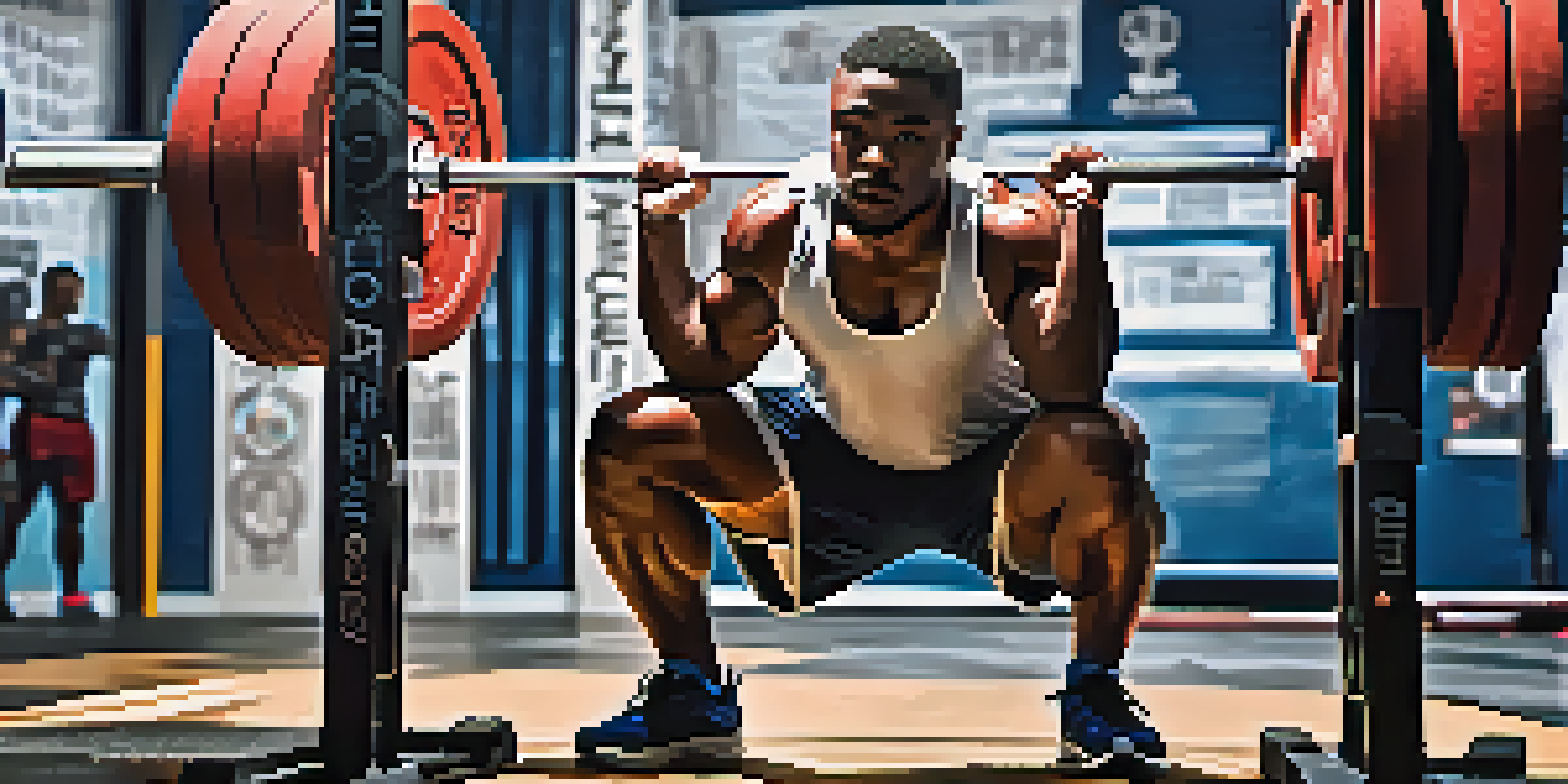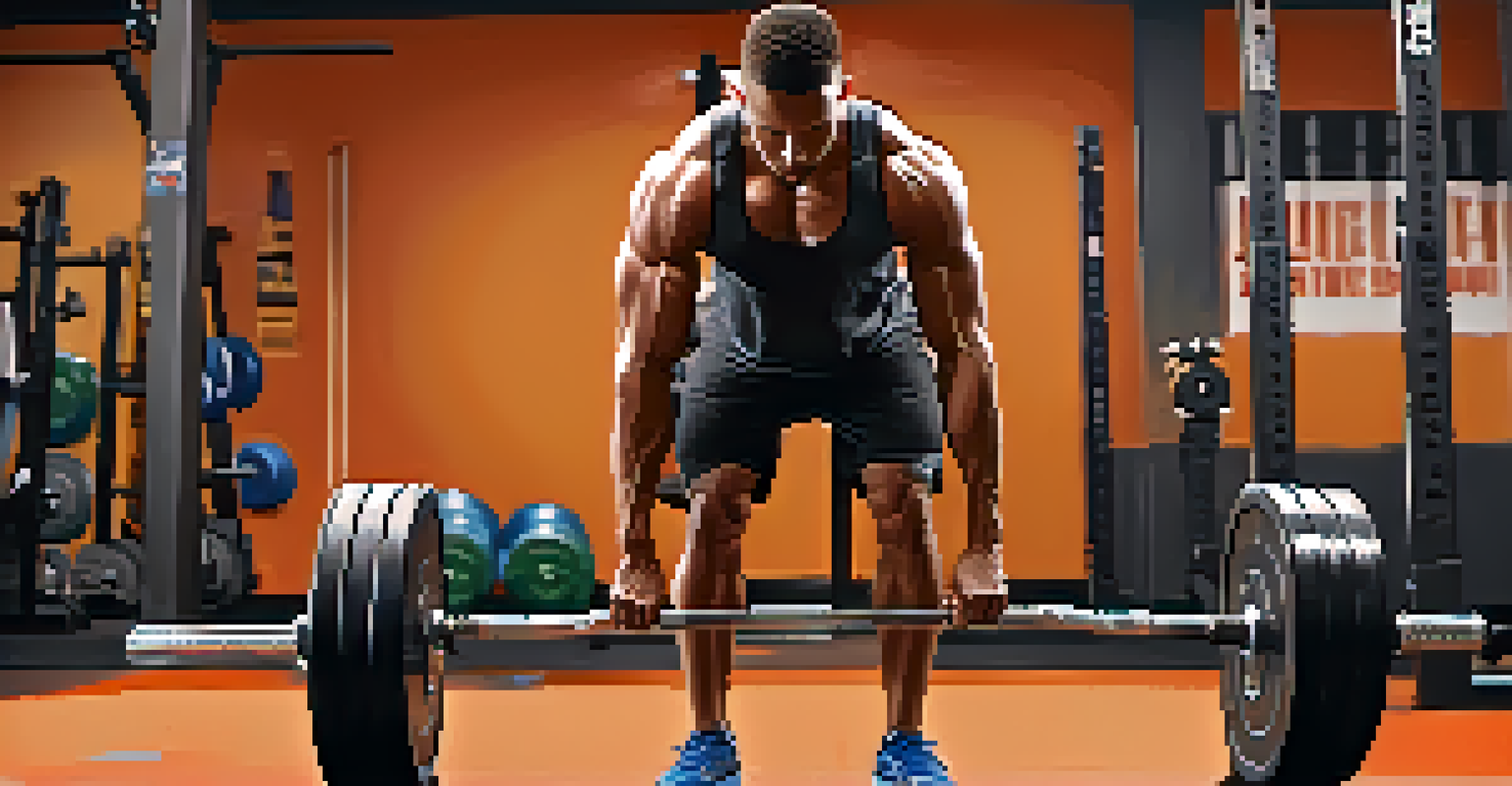Essential Powerlifting Techniques Every Beginner Should Master

Understanding the Powerlifting Basics: Squat, Bench, Deadlift
Powerlifting revolves around three main lifts: the squat, bench press, and deadlift. These foundational exercises assess your strength and overall fitness. Each lift has its own unique technique, which is crucial for maximizing performance and minimizing injury risk.
Strength does not come from physical capacity. It comes from an indomitable will.
Beginners often focus solely on lifting heavier weights, but mastering form is essential. Proper technique ensures you engage the right muscles effectively and can lead to better results in the long run. It's like learning to ride a bike; you need to master balance before you can speed off.
As you progress, understanding the nuances of each lift will set you apart from others. Remember, it's not just about how much you can lift, but how well you can lift it. With practice, these lifts will become second nature.
The Importance of Proper Warm-Up Techniques
Warming up is often overlooked but is a key component of any powerlifting routine. A good warm-up prepares your muscles and joints, reducing the risk of injury. Think of it as getting your engine running before hitting the highway; you want everything to function smoothly.

Incorporate dynamic stretches and light cardio to increase blood flow and flexibility. Movements like leg swings, arm circles, and bodyweight squats can effectively prime your body for heavier lifts. This prep work can make a significant difference in your performance.
Master the Basics of Powerlifting
Focusing on proper form in the squat, bench press, and deadlift is essential for maximizing performance and reducing injury risk.
Always allocate time for warming up, even if you feel pressed for time. A proper warm-up can help you lift more effectively and safely, allowing you to progress faster in your powerlifting journey.
Mastering the Squat: Form and Technique Tips
The squat is a powerhouse lift that engages multiple muscle groups, but mastering the form is key. Start with your feet shoulder-width apart, and ensure your knees track over your toes. This alignment is like the foundation of a house; if it's not solid, everything else may crumble.
The secret of change is to focus all of your energy not on fighting the old, but on building the new.
As you lower into the squat, keep your chest up and back straight. This position helps maintain balance and prevents undue strain on your lower back. Imagine sitting back into a chair; this mental cue can help you achieve the right depth and form.
Practice with lighter weights or just your body weight to perfect your technique. Over time, as your confidence grows, gradually increase the load. Consistent practice will not only improve your squat but also your overall strength.
Perfecting the Bench Press: Key Techniques to Remember
The bench press is a staple for building upper body strength. To execute it properly, lie flat on the bench with your feet firmly planted on the ground. This stable base is essential for generating power, much like a solid foundation helps support a building.
Grip the bar slightly wider than shoulder-width and keep your wrists straight. Lower the bar to your chest while maintaining control, and ensure your elbows are at about a 45-degree angle. This will help protect your shoulders and promote better lifting mechanics.
Fuel Your Body for Better Lifts
A balanced diet rich in protein, carbohydrates, and hydration is crucial for recovery and performance in powerlifting.
As you press the bar back up, think about driving through your feet. This full-body engagement can significantly enhance your lifting power. Remember, bench pressing is not just about your arms; it's a coordinated effort that includes your entire body.
Deadlift Techniques: Getting It Right from the Start
The deadlift is a fantastic full-body exercise, but it's crucial to learn the correct technique early on. Start by standing with your feet hip-width apart and the barbell over the middle of your feet. This positioning is key to lifting efficiently and safely, much like setting up a good stance in sports.
Bend at your hips and knees to grip the bar, ensuring your back is straight and chest is up. Engage your core before lifting, which acts as a natural brace and helps protect your spine. Visualize pushing through your heels as you lift; this will help you use your legs effectively.
Practice with lighter weights until you feel comfortable with the movement. As with any lift, the better your technique, the more weight you’ll be able to handle in the long run. Consistency and attention to form are your best friends in powerlifting.
The Role of Core Strength in Powerlifting
A strong core is vital for successful powerlifting, as it stabilizes your body during lifts. Think of your core as the trunk of a tree; without a strong trunk, the branches (your limbs) can’t support the weight. Core exercises like planks and Russian twists can enhance your stability.
By engaging your core, you create intra-abdominal pressure, which helps protect your spine and improve lifting efficiency. This is especially important during heavy lifts where proper alignment is essential. It's all about creating a solid foundation for your lifts.
Prioritize Recovery for Progress
Incorporating rest, sleep, and recovery techniques is vital for preventing injuries and enhancing overall lifting performance.
Incorporate core-strengthening exercises into your routine to build a robust midsection. The stronger your core, the better your overall performance in all three powerlifting lifts. Remember, a powerful lift starts with a powerful core.
Nutrition for Powerlifting: Fueling Your Body Right
Nutrition is an often underrated aspect of powerlifting, yet it plays a crucial role in your performance. Proper fuel helps you recover faster and lift heavier. Think of your body as a car; without quality fuel, performance drops, and parts can wear out.
Focus on a balanced diet rich in protein, carbohydrates, and healthy fats. Protein is essential for muscle repair, while carbs provide the energy needed for intense workouts. Don’t forget to hydrate; water is vital for optimal performance and recovery.

Develop a meal plan that aligns with your training schedule, ensuring you’re properly fueled before and after workouts. The right nutrition can make a significant difference in your gains and overall powerlifting journey.
Recovery Techniques: Rest and Repair for Lifters
Recovery is just as important as training in the world of powerlifting. Giving your body time to rest and repair can prevent injuries and enhance performance. Think of recovery as the glue that holds your training together; without it, everything can fall apart.
Incorporate rest days into your weekly routine and listen to your body's signals. Techniques like foam rolling, stretching, and even massage can help alleviate soreness and improve flexibility. Just like a well-oiled machine needs maintenance, your body needs care.
Prioritize sleep as it plays a significant role in muscle recovery and overall health. Aim for at least 7-9 hours per night to ensure your body is adequately refreshed and ready for your next workout. Remember, a well-rested lifter is a stronger lifter.